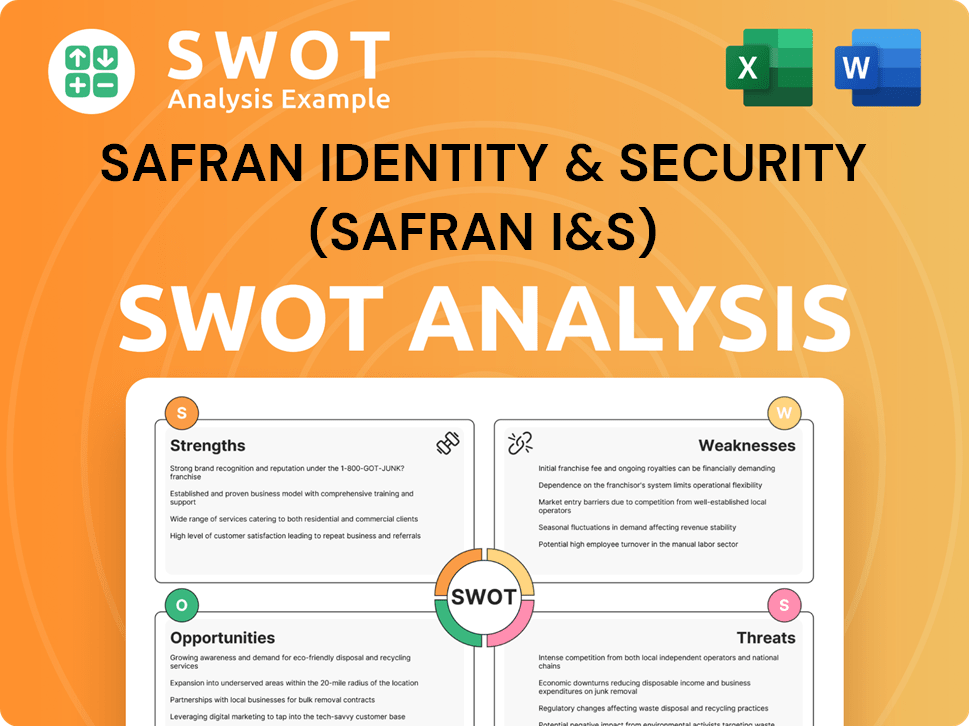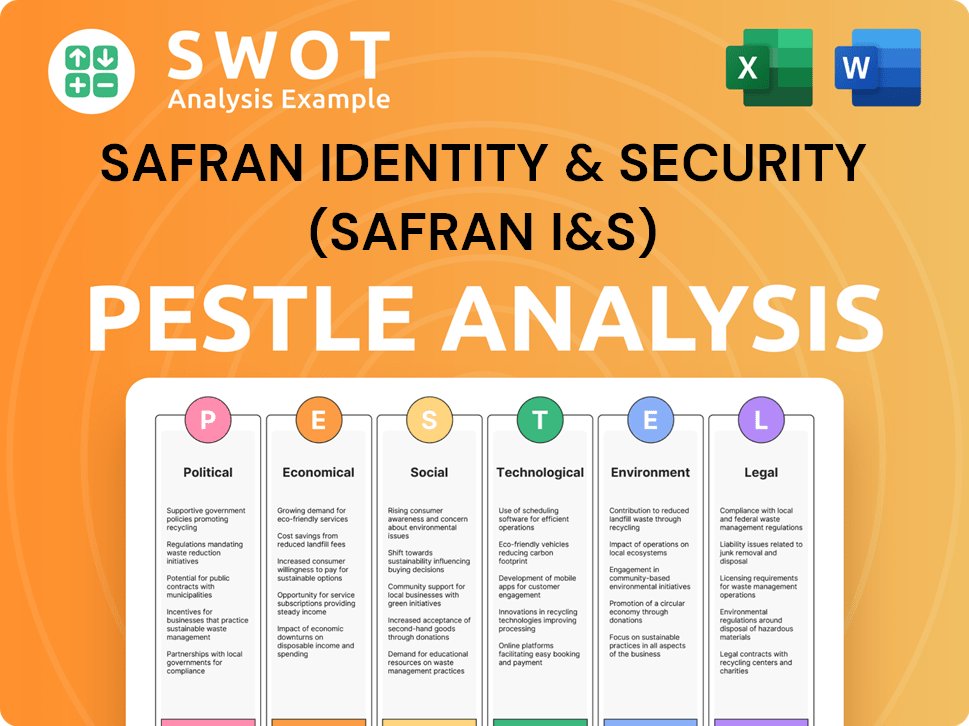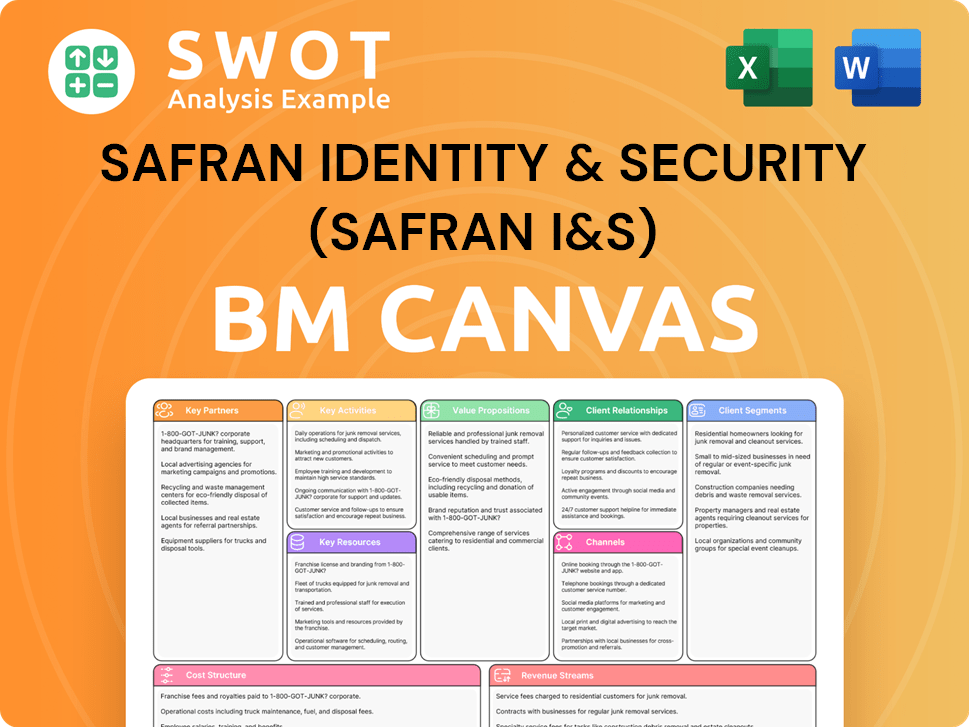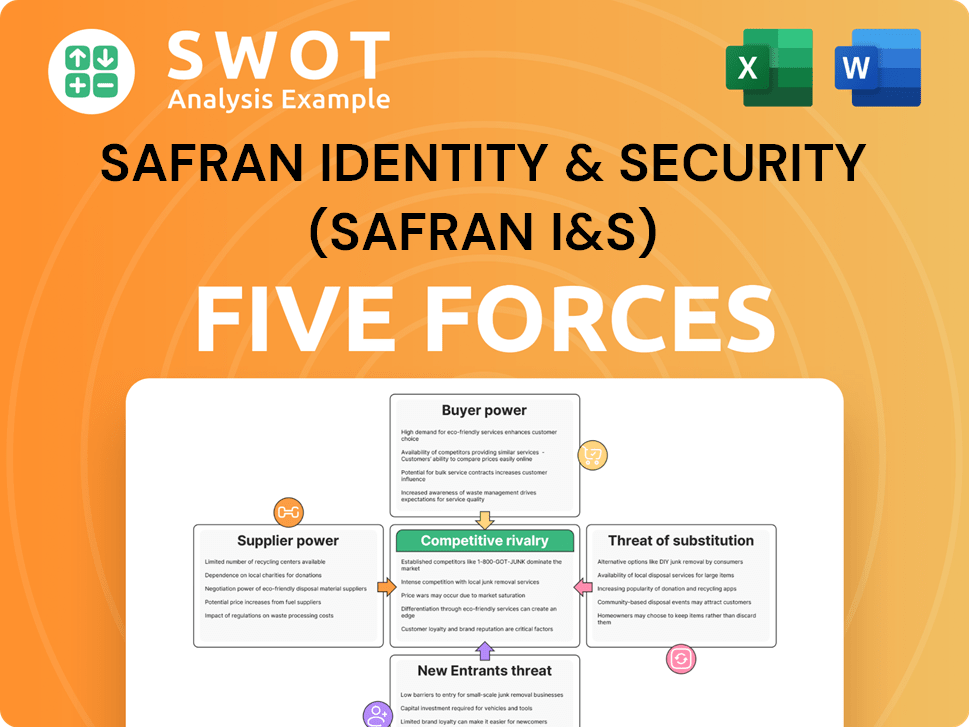Safran Identity & Security (Safran I&S) Bundle
Who are the Key Players Challenging Safran Identity & Security (Safran I&S)?
The digital world demands robust security, and Safran Identity & Security (Safran I&S) SWOT Analysis, now known as Morpho, is a pivotal player in this arena. Its evolution from a specialized unit to a global entity reflects the growing need for advanced identity solutions and secure transactions. This market analysis will dissect the competitive landscape, revealing the forces shaping Morpho's journey.

Morpho's success hinges on navigating a complex ecosystem of competitors. Understanding the competitive landscape of Safran I&S, including its market share and product offerings, is crucial for investors and strategists alike. This exploration will provide insights into the biometric technology and security solutions that define the industry, while also examining the challenges and opportunities faced by Morpho in a dynamic market. We'll delve into a competitive analysis of Safran I&S, its key executives, and its strategic partnerships.
Where Does Safran Identity & Security (Safran I&S)’ Stand in the Current Market?
Morpho, now integrated within Idemia, held a significant market position in the identity and security sector. Its operations spanned several key areas, including biometrics, secure transactions, and digital identity solutions. This legacy has positioned Idemia as a global leader in augmented identity, with a broad portfolio of products and services designed to meet the evolving needs of various sectors.
The company's value proposition lies in its ability to provide comprehensive and integrated identity solutions. This includes biometric devices, secure credentials, payment solutions, and digital identity management platforms. Idemia's focus on innovation and its strong global presence, serving governments, financial institutions, and enterprises, underscores its commitment to delivering cutting-edge security technologies.
Idemia, incorporating the former Morpho's capabilities, generated €2.8 billion in revenue in 2023, demonstrating its financial strength and market leadership. A significant portion of its revenue, over 15%, is reinvested in research and development annually, ensuring its technological edge. This commitment to innovation is crucial for maintaining its competitive advantage in the dynamic field of identity and security.
Idemia, which includes the former Morpho, has a strong global presence, serving diverse customer segments. These include governments, public security organizations, financial institutions, and enterprises. Its wide geographical reach allows it to address the specific security needs of various regions and sectors effectively.
Idemia's primary offerings include biometric devices and systems, secure credentials (passports, national ID cards), payment solutions, and digital identity management platforms. These comprehensive offerings cater to a wide range of security needs, from physical to digital identity verification.
Idemia's strategic focus is on integrated and comprehensive identity and security solutions. This approach bridges physical and digital security needs, emphasizing digital transformation and advanced authentication methods. The company's investments in R&D and its strong position in government programs and the financial sector highlight its strategic priorities.
Idemia's financial performance reflects its leadership in the augmented identity market. The company's substantial revenue and consistent investment in innovation underscore its commitment to maintaining a technological edge. Idemia's financial health supports its ability to compete effectively and expand its market presence.
Idemia, which incorporates the former Morpho's strengths, benefits from a strong global presence and a comprehensive suite of products and services. Its focus on R&D and its strategic positioning in key sectors, such as government and finance, further strengthen its market position. Idemia's financial stability supports its long-term growth and competitive advantage.
- Strong global presence and market share in identity solutions.
- Comprehensive product portfolio including biometric technology and secure credentials.
- Consistent investment in R&D, with over 15% of revenue reinvested annually.
- Strategic focus on integrated identity and security solutions.
Safran Identity & Security (Safran I&S) SWOT Analysis
- Complete SWOT Breakdown
- Fully Customizable
- Editable in Excel & Word
- Professional Formatting
- Investor-Ready Format

Who Are the Main Competitors Challenging Safran Identity & Security (Safran I&S)?
The competitive landscape for Safran Identity & Security (Safran I&S), formerly known as Morpho, is multifaceted, encompassing specialized biometric firms, large IT service providers, and diversified technology conglomerates. Understanding the competitive landscape is crucial for assessing Safran I&S's market position and strategic direction. This analysis helps in evaluating Safran I&S's market share and identifying potential growth areas.
Safran I&S faces competition across various segments of the identity and security market. The company's focus on biometric technology and identity solutions places it in direct competition with several established players. This competitive analysis of Safran I&S involves evaluating its strengths, weaknesses, opportunities, and threats in relation to its rivals.
The industry has seen significant consolidation, as highlighted by the formation of Idemia through the merger of Oberthur Technologies and Morpho. For more information on the company's history, refer to the Brief History of Safran Identity & Security (Safran I&S).
Key direct competitors of Safran I&S include Thales and HID Global. These companies offer similar identity solutions and compete for contracts in government and enterprise sectors. Their product offerings often overlap with Safran I&S's, particularly in biometric technologies and secure document issuance.
Thales is a major competitor, especially in digital identity and security. Thales competes directly with Safran I&S in biometric data management and secure document issuance. Thales leverages its extensive defense and security portfolio and strong governmental relationships.
HID Global, a subsidiary of Assa Abloy, is a strong competitor in access control, secure issuance, and identity verification. HID Global offers a wide range of products, including smart cards, readers, and biometric solutions. HID Global's strength lies in its robust distribution network and comprehensive product portfolio.
NEC Corporation is a significant competitor, particularly in advanced biometric technology like facial recognition and fingerprint identification. NEC has a long history of innovation and deployment in large-scale government projects globally. NEC's focus on innovation makes it a strong contender in the market analysis of biometric solutions.
Large technology companies such as Google, Apple, and Microsoft also pose indirect competition. These companies integrate identity verification and biometric authentication into their platforms and devices. Their influence shapes consumer expectations and drives new industry standards.
Emerging players focusing on blockchain-based identity solutions and decentralized identity also present a disruptive threat. These technologies could reshape how identity is managed and verified in the future. The evolving landscape requires Safran I&S to adapt and innovate to maintain its industry position.
Analyzing the competitive landscape involves several critical factors. Understanding Safran I&S's product offerings, financial performance, and key executives is crucial. In-depth market analysis helps in assessing the company's strengths and weaknesses.
- Safran I&S must continuously adapt to technological advancements.
- The company should monitor Safran I&S's acquisitions and mergers.
- Safran I&S needs to evaluate its strategic partnerships.
- Analyzing the Safran I&S's customer base provides insights into market dynamics.
Safran Identity & Security (Safran I&S) PESTLE Analysis
- Covers All 6 PESTLE Categories
- No Research Needed – Save Hours of Work
- Built by Experts, Trusted by Consultants
- Instant Download, Ready to Use
- 100% Editable, Fully Customizable

What Gives Safran Identity & Security (Safran I&S) a Competitive Edge Over Its Rivals?
Understanding the competitive landscape of Safran Identity & Security (Safran I&S) involves a deep dive into its core strengths and market positioning. Formerly known as Morpho, the company has built a robust foundation in identity solutions. This analysis is crucial for anyone looking to understand the dynamics of biometric technology and the broader security market. A key aspect of this analysis involves assessing the company's competitive advantages in a rapidly evolving industry.
The company's competitive edge is shaped by its technological prowess, brand reputation, and global reach. This article will explore the factors that contribute to its success and the challenges it faces. The market analysis reveals that Safran I&S has a significant presence in both government and commercial sectors. This positions the company as a key player in the global security market.
Safran I&S, now operating under the Idemia brand, continues to be a major player in the identity and security sector. Its strategic moves, key milestones, and competitive strengths are critical to understanding its market position. The company's history, including its evolution from Morpho, highlights its ability to adapt and innovate. A detailed look at its competitive advantages is essential for evaluating its long-term prospects.
Safran I&S holds a vast portfolio of patents, driving its technological leadership in biometric technologies. The company invests heavily in R&D, with over 15% of its revenue allocated annually to innovation. This continuous investment ensures its advanced biometric algorithms and systems remain cutting-edge, setting it apart in the competitive landscape.
The company's brand equity, built over decades, fosters strong customer loyalty. Its reputation for reliability and expertise in handling sensitive projects is a significant advantage. This is especially true with long-term government contracts for national ID programs and border control systems, ensuring a stable customer base.
Safran I&S's extensive distribution networks and strategic partnerships are crucial for reaching diverse markets. These partnerships enable the effective delivery of complex solutions worldwide. This global presence allows the company to capitalize on opportunities in various regions, enhancing its market share and competitive position.
The company's talent pool, comprising researchers, engineers, and security experts, is a key asset. This expertise drives continuous innovation and allows the company to adapt to evolving security threats. This focus on talent ensures the company remains at the forefront of technological advancements.
Safran I&S's competitive advantages stem from its technological leadership, brand equity, global presence, and talented workforce. These strengths are crucial for maintaining its position in the market. The company's ability to innovate and adapt is essential for long-term success in the industry.
- Extensive intellectual property in biometrics.
- Strong brand reputation and customer loyalty.
- Global distribution networks and strategic partnerships.
- A team of researchers, engineers, and security experts.
Safran Identity & Security (Safran I&S) Business Model Canvas
- Complete 9-Block Business Model Canvas
- Effortlessly Communicate Your Business Strategy
- Investor-Ready BMC Format
- 100% Editable and Customizable
- Clear and Structured Layout

What Industry Trends Are Reshaping Safran Identity & Security (Safran I&S)’s Competitive Landscape?
The competitive landscape for Safran Identity & Security (Safran I&S) is dynamic, shaped by rapid technological advancements and evolving market demands. Understanding the current market position, potential risks, and future outlook is crucial for stakeholders. This includes a detailed market analysis of Safran I&S, its competitors, and the broader industry trends.
The company must navigate intense competition, regulatory changes, and the constant threat of cyberattacks. However, significant opportunities exist in emerging markets and the growing demand for secure digital transactions. The future success of Safran I&S will depend on its ability to innovate, adapt, and forge strategic partnerships.
The identity and security industry is currently experiencing significant shifts. The integration of artificial intelligence and machine learning is enhancing biometric accuracy, with the global AI in cybersecurity market projected to reach approximately $60 billion by 2028. Decentralized identity solutions, often using blockchain, are gaining traction, potentially reshaping traditional identity management. Regulatory changes, like the GDPR, and the rise of national digital identity programs are also key drivers.
Safran I&S faces several challenges. These include the need for continuous R&D investment to stay ahead technologically. Competition from agile startups and large tech companies integrating identity solutions is increasing. The persistent threat of cyberattacks requires constant vigilance and innovation in security protocols. Navigating complex and evolving global regulatory landscapes also presents a significant hurdle.
Significant growth opportunities exist for Safran I&S. Emerging markets, particularly in Asia and Africa, are investing heavily in digital identity programs. The expanding demand for secure digital transactions in e-commerce and banking presents a major market. Product innovations, such as multimodal biometrics and verifiable credentials, offer avenues for diversification. Strategic partnerships can unlock new markets and accelerate solution development.
To capitalize on these trends, Safran I&S is likely focusing on several strategic initiatives. These include investing in cutting-edge biometric technologies, expanding its presence in high-growth markets, and forming partnerships with key players in the financial and technology sectors. The company is also likely enhancing its cybersecurity offerings to address the increasing threats in the digital landscape. Furthermore, it is crucial for Safran I&S to maintain a strong focus on regulatory compliance and data privacy to build and maintain customer trust.
The identity solutions market is experiencing robust growth, driven by increased digitalization and security concerns. The global biometric system market is expected to reach $86.7 billion by 2027. This growth is fueled by the need for secure authentication in various sectors. Key players in this market include large technology firms and specialized security providers, creating a competitive environment.
- Technological Advancements: AI and machine learning are improving biometric accuracy and fraud detection.
- Regulatory Landscape: Stricter data privacy regulations like GDPR necessitate compliance.
- Market Expansion: Emerging markets offer substantial growth potential through national digital identity programs.
- Competitive Pressure: Competition is increasing from both startups and established tech giants.
Safran Identity & Security (Safran I&S) Porter's Five Forces Analysis
- Covers All 5 Competitive Forces in Detail
- Structured for Consultants, Students, and Founders
- 100% Editable in Microsoft Word & Excel
- Instant Digital Download – Use Immediately
- Compatible with Mac & PC – Fully Unlocked

Related Blogs
- What are Mission Vision & Core Values of Safran Identity & Security (Safran I&S) Company?
- What is Growth Strategy and Future Prospects of Safran Identity & Security (Safran I&S) Company?
- How Does Safran Identity & Security (Safran I&S) Company Work?
- What is Sales and Marketing Strategy of Safran Identity & Security (Safran I&S) Company?
- What is Brief History of Safran Identity & Security (Safran I&S) Company?
- Who Owns Safran Identity & Security (Safran I&S) Company?
- What is Customer Demographics and Target Market of Safran Identity & Security (Safran I&S) Company?
Disclaimer
All information, articles, and product details provided on this website are for general informational and educational purposes only. We do not claim any ownership over, nor do we intend to infringe upon, any trademarks, copyrights, logos, brand names, or other intellectual property mentioned or depicted on this site. Such intellectual property remains the property of its respective owners, and any references here are made solely for identification or informational purposes, without implying any affiliation, endorsement, or partnership.
We make no representations or warranties, express or implied, regarding the accuracy, completeness, or suitability of any content or products presented. Nothing on this website should be construed as legal, tax, investment, financial, medical, or other professional advice. In addition, no part of this site—including articles or product references—constitutes a solicitation, recommendation, endorsement, advertisement, or offer to buy or sell any securities, franchises, or other financial instruments, particularly in jurisdictions where such activity would be unlawful.
All content is of a general nature and may not address the specific circumstances of any individual or entity. It is not a substitute for professional advice or services. Any actions you take based on the information provided here are strictly at your own risk. You accept full responsibility for any decisions or outcomes arising from your use of this website and agree to release us from any liability in connection with your use of, or reliance upon, the content or products found herein.